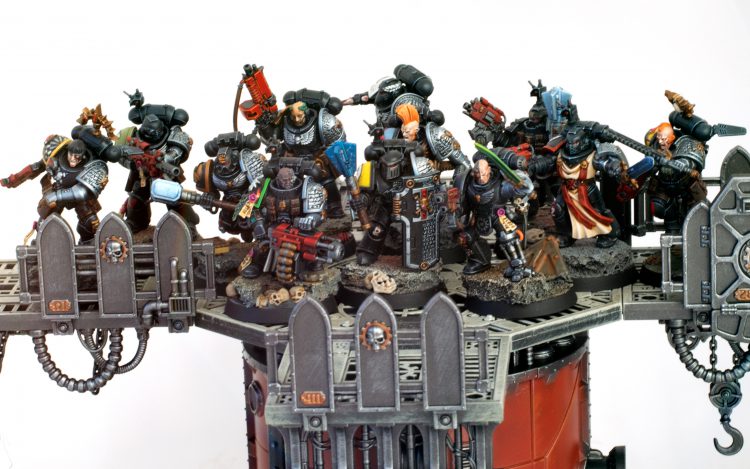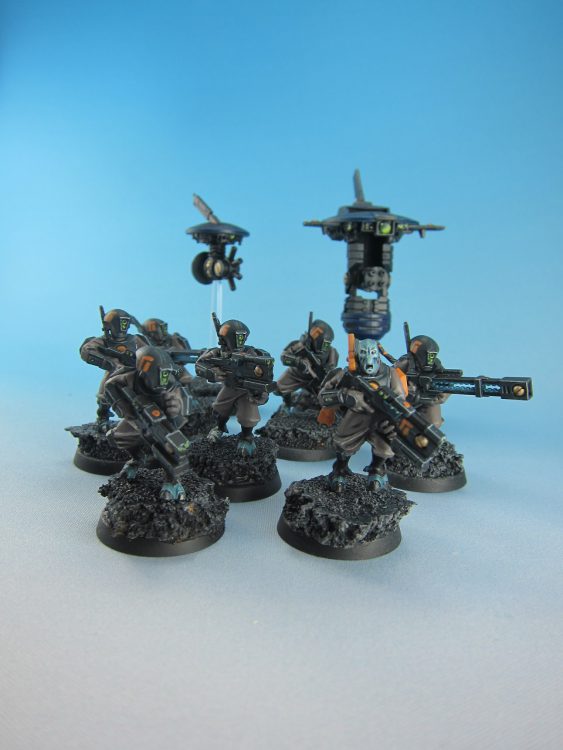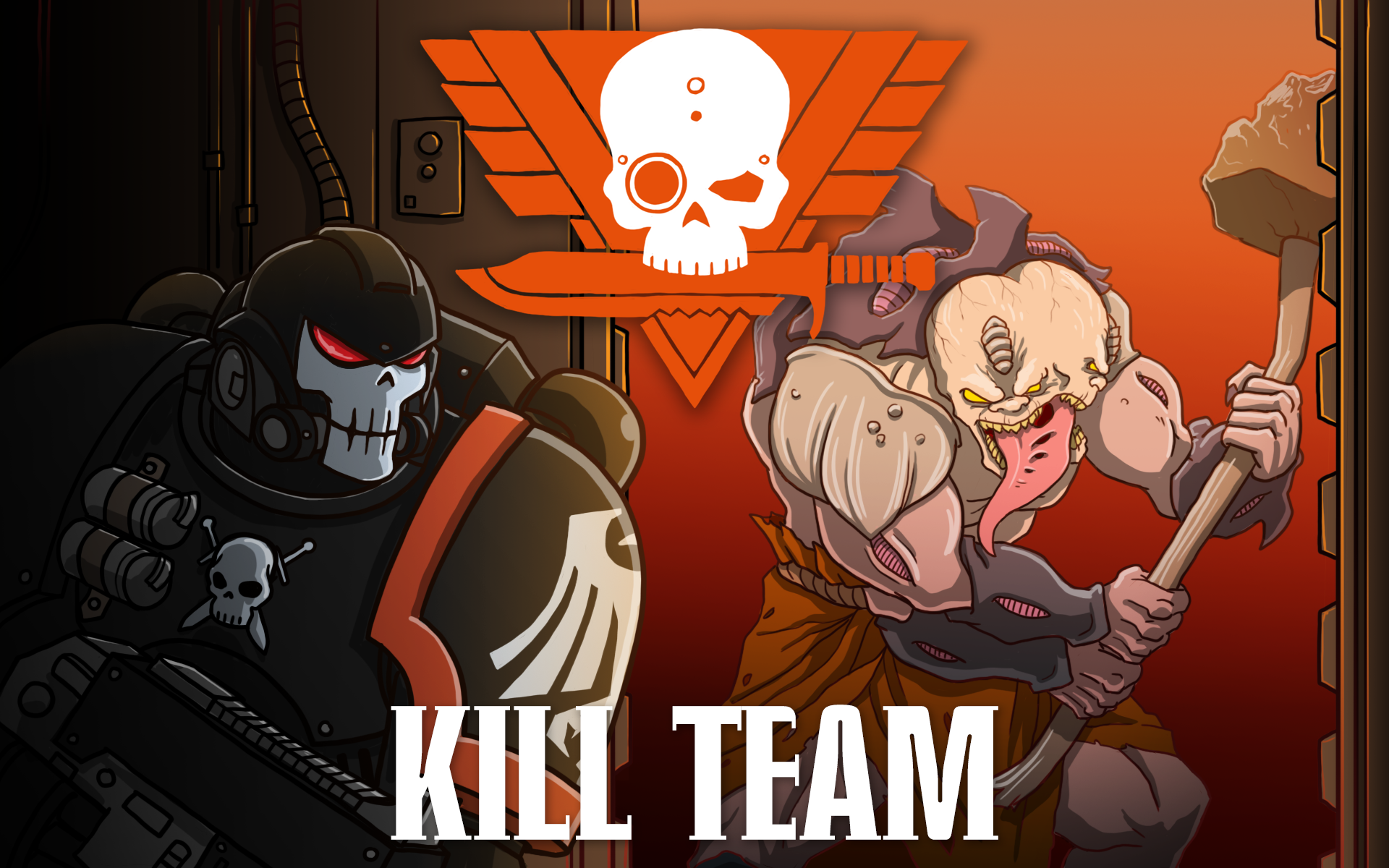We recently spent a good deal of time talking about where Kill Team is and how much we enjoy it as a competitive game. But many players may find competitive play daunting, or be unsure about how it differs from casual or Narrative play. In today’s article, we’re going to introduce you to what competitive Kill Team is. Not just the rules, but why they are the way they are and what those rules mean to you as a player. It’s worth noting that you also don’t need to actually play at tournaments to enjoy these rules – Competitive Kill Team is a blast whether you’re playing in a tournament bracket or casually with friends, and the rules give you a relatively balanced way to play the game that forces you to make interesting decisions every turn. In this article, NovemberMike and Shane Watts are talking about what makes Competitive Kill Team so great, and what you need to know about it.
Table of Contents
A History Lesson
This is going to be a brief lesson since Kill Team’s only been out about a year. When it was first released there were a few small tournaments that ran using the Matched Play rules. There were a few issues with that. First, they used the scouting rules, which were just a mistake. Second, if your team broke you lost. This really punished hordes and teams with lower leadership, and was just sort of anticlimactic since the game ended on a random roll. Third, they tended to use missions that could boil down to 1 kill = 1 vp.
This meant that you just wanted teams that were relatively tough and put out a lot of damage. If you’ve heard complaints about Frag Cannons they were probably talking about these missions. The most competitive lists were things like Death Guard with lots of special weapons, Imperial Guard with lots of plasma and few other lists could compete.
GW actually saw these issues and responded (or maybe they pre-empted it, they acted pretty fast). NOVA 2018 saw the release of a tournament rule set that fixed most of these issues. To start with,they completely ditched the scouting phase and got rid of the rule where breaking caused you to lose. They also moved to victory conditions that emphasize holding territory and give you a choice of secondaries that let you tailor the mission to your army.
These changes open up the game to many more armies. The ability to kill naturally works into the goal of holding ground since the enemy can’t hold objectives if they’re dead, but it’s also possible for hordes to play a delaying game while working the objective. You want speed, durability, firepower and numbers, and every team has their own mix of those traits to the game.
Since NOVA 2018 we’ve seen similar rules used at the Las Vegas Open, Adepticon and NOVA 2019, and Games Workshop released Arena, which uses similar rules on a 2d terrain board that is surprisingly good value and makes it easy to set up more competitive games.
Shane: It’s important to note that with the release of the Elites expansion there have been events that have been testing the waters on expanding past 100-point teams for competitive events. A few of the events like SoCal have been using 125-point teams, and that’s something we’ll see with LVO as well (though NOVA still is using 100pts). There seems to be real momentum for events trending in that direction.

The Rules
We’re going to reference the Adepticon mission packet, which you can find here. There are a few variations of this floating around, but they mostly differ on details like how terrain is set up, which isn’t important for an overview. They go like this:
- Each Player starts with a roster of 20 models from the same faction and gives their opponent a copy of this roster.
- The mission is determined.
- Each player generates a legal 100-point kill team and chooses three secondary objectives that are part of the mission.
- Skip the scouting phase.
- Players deploy normally.
- At the end of each battle round players score primary and secondary objectives. You get at most 9 points for primaries and 3 points for each secondary.
- At the end of the game the player with the most points wins, and there is no penalty for breaking.
There are a few variations, but the primary objective is usually centered around holding more objectives than your opponent and there is usually a list of 6 secondary objectives that are similar to ITC secondaries from 40k.
What do these rules mean?
The most thing to remember with these rules is that they don’t reward you much for killing. There are a few kill secondaries but the most reliable way to get points is to be able to get your models where they need to be and keep them healthy enough to score. In this model a horde starts off winning and elite teams need to be able to clear out enough that they get the momentum before the game is lost.
To give an idea, imagine 5 Grey Knights against 19 Gaunts and a Tyranid Warrior on the first mission in the packet I linked. The Grey Knights player has two secondaries that involve killing, Bounty Hunters (kill things and go to where they died) and Cut Apart (kill things in the fight phase), and they must choose one of the remaining secondaries that involve movement. They probably take the bespoke objective, Mission Critical Supplies, since they’re going to lose if they can’t take the center objective anyway. The Tyranids can just take movement objectives, such as Domination (more models within 3″ of the center), Engage on all fronts (have models in all four quadrants) and Mission Critical supplies (control the center objective).
For this example we’re going to assume that the Grey Knights are unrealistically good and always kill 4 enemies a turn, and the Tyranids are unrealistically bad and never injure anything.
Turn 1: Both players move out of their deployment zones. The deployment zones are 6″ from the center of the map so the Tyranids player can easily get models into all four quadrants for Engage on All Fronts, and they can also easily throw 6+ models into the center so the Grey Knights player can’t take the center. Grey Knights need to take the two objectives in their deployment zone so they’re down two models and they need to send most of their force towards the middle objective. We’re going to assume that they get Cut Apart and Bounty Hunters, and they get two points for primaries. GK 4 – Tyranids 6
Turn 2: Tyranids are down to 12 models at the end of this turn since they lost 4 last turn and they’ll lose 4 this turn as well. That’s still enough to get all of their points and they can potentially contest the objectives in the GK deployment zone. GK could potentially get zero primary points this turn and only get their kill secondaries, but we’ll assume they kept one of their objectives to be nice. GK 7 – Tyranids 12
Turn 3: Tyranids will go down to 8 models this turn, which will force a break test, but even if the Nids break they can stay in synapse of the warrior and get all of their points. It’s unlikely that they can contest the GK’s objectives though, so the Grey Knights will get at least their two kill secondaries and their two points of primaries. GK 11 – Tyranids 18
Turn 4: Tyranids are down to 4 models and can’t contest much, but they’re also already maxed out. The Grey Knights player can’t score any more points on Cut Apart or Bounty Hunters and have at most 4 points available. GK 15 – Tyranids 18, game ends.
This was an extreme example but these are both lists that have seen play at tournaments and the scenario I drew out is unrealistically bad for the Tyranids. They should almost always be maxing points against an elite list and the elite team should never be maxing points against them.
After hearing this you might be thinking that the situation is dire and it’s really not. This Tyranid list is one people have both played and won with, but there are a number of intermediate factions like Ad Mech, Imperial Guard, Aeldari, Tau and many more that play with more models than the Grey Knights but don’t sacrifice all of their killing power like pure hordes do. They’re still playing the objective games and they still lose to a horde on turn 1, but they have the firepower and numbers to turn the game around by turn 3 and come out ahead.
If you’ve read a few of our reviews this is why I’m generally less impressed by flashy models like Terminators. They’re cool and fun but they tend to put you in the elite team pit and make the game all about climbing out of that pit. The best teams tend to have a lot of models that all do a job well and you can park them on the objectives after they’ve done the job.

LVO
For the 2020 Las Vegas Open (LVO), they’re setting up a packet that’s more similar to ITC (Shane: LVO 2020 is also using 125 points instead of the usual 100 points). You have the following Primary Objectives:
- 1 point for Killing 1 model
- 1 point for Killing more models than your opponent
- 1 point for Holding 1 objective
- 1 point for Holding more objectives than your opponent.
You can get up to 4 primary points a turn and up to 12 points from primaries a game. That means you need to score 4 points 3 times (very difficult) or 3 points on 4 turns (still difficult but doable). The big tension here is that elite teams will be stronger per model offensively and defensively so they’re likely to score kill more, while larger teams are more likely to hold more objectives, but no matter what you need to be able to kill at least one model a turn and hold one objective a turn.
You also get to choose 3 Secondary Objectives, but unlike the older missions you can always choose from all 18 objectives. This should help lists with cases where the secondaries chosen for the mission favored one strategy over others. There’s also a set of relatively neutral and hard to achieve bonus objectives that are unique for each mission and can get you an extra 3 points.
I’ve only played a single test game with these rules, but I’m excited. The tension between holding and killing is an actual tension. Teams like Custodes are very capable of killing enemies without losing anything which gets Kill 1 and Kill More and denies those to the enemy for a 4 point swing, but they need to take reasonable secondaries. Pure hordes probably aren’t viable but 10+ model teams have a lot of activations that make more secondaries viable to take and they can usually kill an enemy model each turn so they can max out primaries against a lot of teams.
One other takeaway was that some of the elite models that you don’t normally take like Bullgryns or Wraithguard can be good because they can play aggressively without dying and giving up points. In the other competitive mission sets you care about having more models active for more turns, but with these missions being able to win a fight is important.
Shane: I have been running Kill Team events with the inclusion of Kill primary objectives, and overall the responses from players has been positive. Being able to give teams that are forced into a low model count (see: Grey Knights, Deathwatch, Custodes, etc) a fighting chance versus a pure horde lists, as opposed to mostly an auto loss, is really refreshing.
Conclusion
There’s a few things we’d like you to take away from this article. First, I hope it cleared up how the competitive games are played and why you didn’t see a lot of Terminators and Lictors duking it out at the top tables of SoCal open (and why that might not mean much if you’re going to LVO). Kill Team has a consistent set of rules but the missions change and they do a lot to set the meta.
Second, I hope that you’re seeing how we evaluate models in our Kill Team Tactics series and when you can ignore us. My ratings for AdMech and Marines were based on the competitive missions played at NOVA and Socal open, and while a lot of things stay the same in a different rule mission set like LVO has some things do change when you prioritize killing a bit more.
Third, I hope you can look at what these different missions do to the game and influence your local community to play games you enjoy. The big tournaments are proving grounds but you can play these at local pickup games or tournaments at your local game store. Just because these rules are intended for competitive play doesn’t mean they’re not fun – these rules make for very tight, balanced games with lots of important tactical decisions. They’re just as much fun for players looking for a quick hour-long match as they are for players looking to test their mettle against the best opponents in their area.
We’re currently working on a more detailed guide to the LVO 2020 mission pack so check back in soon for that. In the meantime, if you have any questions or feedback, feel free to drop us a note in the comments below or email us at contact@goonhammer.com.


